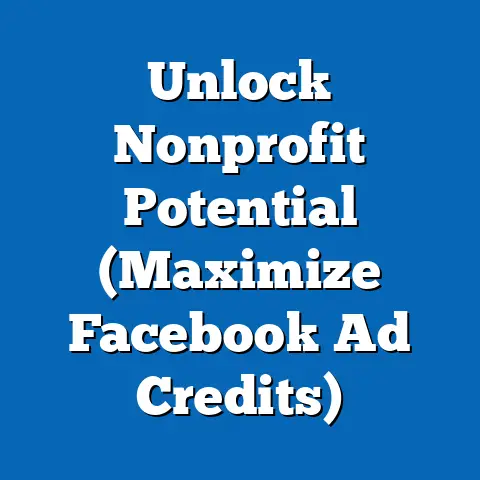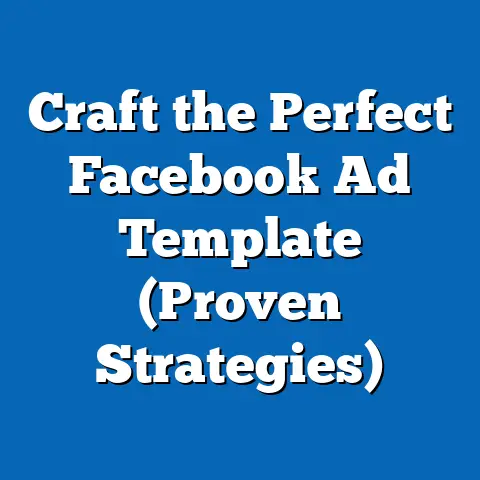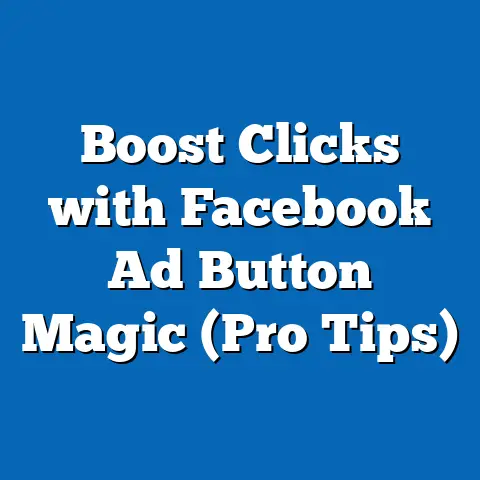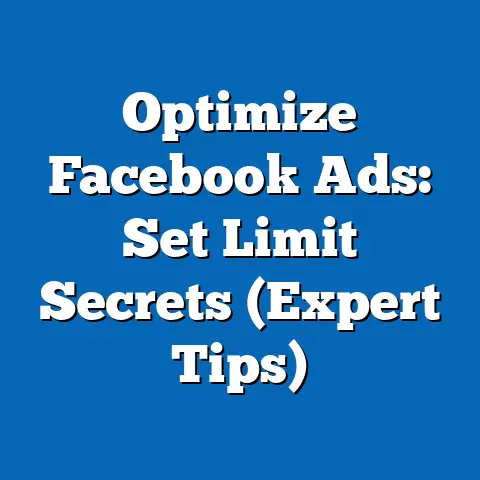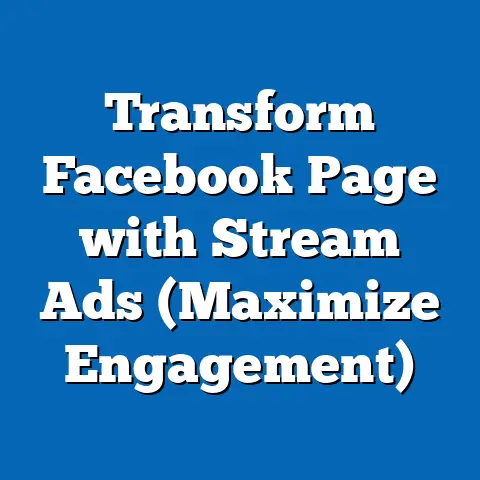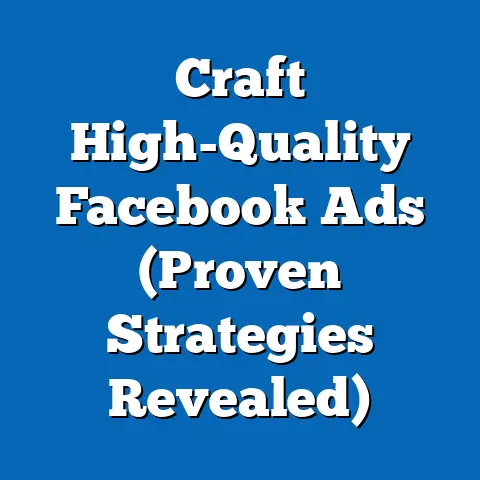Maximize ROI with Top Facebook Ads Strategies (Expert Guide)
Understanding Facebook Ads and Their Ecosystem
Facebook Ads are more than just simple promotions; they are a complex ecosystem within the larger Facebook universe. I remember when Facebook ads first started gaining traction. It felt like the Wild West – everyone was trying anything and everything to see what stuck. Over time, the platform has matured, and so have the strategies required to succeed.
Ad Placements: Where Your Ads Appear
The first thing to understand is where your ads can actually appear. Facebook offers a wide array of placements, each with its own strengths and considerations:
- News Feed: This is the most common and often most effective placement. Ads appear seamlessly within users’ feeds alongside posts from friends and family. The key here is to make your ad look native – like it belongs there.
- Stories: Short-form video or image ads that appear between users’ Stories. Stories are great for capturing attention quickly and showcasing visually engaging content.
- Marketplace: Ideal for e-commerce businesses, Marketplace ads appear alongside products for sale.
- Right Column: A more traditional ad placement on desktop, less prominent than the News Feed but still valuable for certain campaigns.
- Instagram Feed: Leverage the visual power of Instagram by placing ads directly in users’ feeds.
- Instagram Stories: Similar to Facebook Stories, but on the Instagram platform.
- Audience Network: Extend your reach beyond Facebook and Instagram by showing ads on other apps and websites within Facebook’s network.
I’ve found that testing different placements is crucial. What works for one campaign might not work for another. For example, I once ran a campaign for a local restaurant and saw great results with News Feed ads, but the right column ads barely generated any clicks.
Ad Formats: Choosing the Right Canvas
Facebook offers a variety of ad formats to suit different objectives and creative assets:
- Single Image Ads: A classic and versatile format. Use high-quality images that grab attention.
- Single Video Ads: Video is incredibly engaging and can convey a lot of information in a short amount of time.
- Carousel Ads: Showcase multiple images or videos in a swipeable format. Great for highlighting different products or features.
- Collection Ads: Designed for e-commerce, Collection Ads feature a catalog of products that users can browse directly from the ad.
- Instant Experience Ads: Full-screen, mobile-optimized experiences that load instantly when a user clicks on the ad.
- Lead Ads: Capture leads directly within Facebook without sending users to an external landing page.
- Slideshow Ads: Create engaging video-like ads from still images.
Choosing the right format depends on your goals, your target audience, and the type of content you have available. When I was working with a fashion brand, we found that carousel ads performed exceptionally well, allowing us to showcase different outfits and styles.
Targeting Options: Zeroing In on Your Ideal Customer
Facebook’s targeting options are incredibly powerful, allowing you to reach specific groups of people based on:
- Demographics: Age, gender, location, education, job title, and more.
- Interests: Hobbies, passions, and things people are interested in.
- Behaviors: Purchase history, online activity, and other behaviors.
- Custom Audiences: Upload your own customer lists or website visitor data to target specific individuals.
- Lookalike Audiences: Find new customers who are similar to your existing customers.
I once worked on a campaign for a travel company that wanted to target people interested in adventure travel. By using Facebook’s interest-based targeting, we were able to reach a highly qualified audience and generate a significant number of bookings.
The Facebook Ads Manager: Your Central Command
The Facebook Ads Manager is your central hub for creating, managing, and optimizing your ad campaigns. It’s where you’ll set your budget, choose your targeting options, design your ads, and track your performance. It can be a bit overwhelming at first, but once you get the hang of it, it’s an incredibly powerful tool.
Key Takeaway: Understanding the Facebook Ads ecosystem is the foundation for successful advertising. Experiment with different placements, formats, and targeting options to find what works best for your business.
Defining Your Goals and Metrics for Success
Before you even think about creating an ad, you need to define your goals. What do you want to achieve with your Facebook ad campaign? Are you trying to increase brand awareness, generate leads, drive sales, or something else entirely?
Setting Clear, Measurable Objectives
Setting clear objectives is crucial because it will guide your entire ad strategy. Here are some common campaign objectives:
- Brand Awareness: Increase the reach and recognition of your brand.
- Reach: Show your ad to the maximum number of people within your target audience.
- Traffic: Drive traffic to your website or landing page.
- Engagement: Increase likes, comments, shares, and other forms of engagement.
- Lead Generation: Collect leads from potential customers.
- Conversions: Drive sales or other desired actions on your website.
- App Installs: Encourage users to download your mobile app.
I’ve learned that being specific is key. Instead of saying “I want to increase brand awareness,” try “I want to increase brand awareness by 20% among women aged 25-34 in the next quarter.”
Identifying Key Performance Indicators (KPIs)
Once you’ve defined your objectives, you need to identify the key performance indicators (KPIs) that will tell you whether you’re on track to achieve them. Here are some common KPIs:
- Click-Through Rate (CTR): The percentage of people who see your ad and click on it.
- Conversion Rate: The percentage of people who click on your ad and complete a desired action (e.g., make a purchase, fill out a form).
- Cost Per Click (CPC): The average cost you pay for each click on your ad.
- Cost Per Acquisition (CPA): The average cost you pay to acquire a new customer.
- Return on Ad Spend (ROAS): The amount of revenue you generate for every dollar you spend on advertising.
- Impressions: The number of times your ad is shown.
- Reach: The number of unique people who see your ad.
- Frequency: The average number of times each person sees your ad.
I always tell my clients to focus on the KPIs that are most relevant to their business goals. If you’re trying to generate leads, focus on your cost per lead. If you’re trying to drive sales, focus on your return on ad spend.
Examples of Campaign Objectives and Their Influence on Ad Strategy
Let’s look at a few examples of how different campaign objectives can influence your ad strategy:
- Objective: Brand Awareness
- Strategy: Focus on reach and frequency. Use visually appealing ads that capture attention and convey your brand message.
- KPIs: Reach, impressions, frequency.
- Objective: Lead Generation
- Strategy: Use lead ads or drive traffic to a landing page with a lead capture form. Offer a valuable incentive in exchange for contact information.
- KPIs: Cost per lead, conversion rate.
- Objective: Conversions
- Strategy: Use conversion-optimized ads that drive traffic to a product page or checkout page. Use retargeting to reach people who have previously visited your website.
- KPIs: Conversion rate, cost per acquisition, return on ad spend.
- Strategy: Focus on reach and frequency. Use visually appealing ads that capture attention and convey your brand message.
- KPIs: Reach, impressions, frequency.
- Strategy: Use lead ads or drive traffic to a landing page with a lead capture form. Offer a valuable incentive in exchange for contact information.
- KPIs: Cost per lead, conversion rate.
- Strategy: Use conversion-optimized ads that drive traffic to a product page or checkout page. Use retargeting to reach people who have previously visited your website.
- KPIs: Conversion rate, cost per acquisition, return on ad spend.
Key Takeaway: Defining your goals and metrics for success is essential for creating effective Facebook ad campaigns. Make sure your objectives are clear, measurable, and aligned with your business goals.
Crafting Compelling Creative Content
Your ad creative is what grabs people’s attention and convinces them to take action. It’s the visual and textual representation of your brand and your offer. I’ve seen campaigns with perfect targeting fail because the creative was uninspired.
The Elements of High-Quality Ad Creative
High-quality ad creative consists of three key elements:
- Visuals: Eye-catching images or videos that capture attention and convey your message.
- Copy: Compelling text that explains your offer and motivates people to take action.
- Calls-to-Action (CTAs): Clear and concise prompts that tell people what you want them to do.
Tips for Creating Eye-Catching Images and Videos
Here are some tips for creating visuals that resonate with your target audience:
- Use high-quality images and videos: Avoid blurry or pixelated images.
- Showcase your product or service in action: Let people see how it works and how it can benefit them.
- Use bright colors and bold fonts: Make your ad stand out from the crowd.
- Use faces: People are naturally drawn to faces, especially smiling ones.
- Keep it short and sweet: Attention spans are short, so get to the point quickly.
I once worked on a campaign for a local bakery that used mouth-watering photos of their pastries. The ads were so effective that people were literally walking into the bakery with the ads pulled up on their phones!
The Role of Storytelling in Ads
Storytelling is a powerful way to connect with your audience on an emotional level. People are more likely to remember and engage with ads that tell a story.
Here are some tips for incorporating storytelling into your ads:
- Focus on the benefits, not the features: Tell people how your product or service will make their lives better.
- Use relatable characters: Make your characters people that your target audience can identify with.
- Create a sense of drama or suspense: Keep people engaged and wanting to know what happens next.
- End with a clear call to action: Tell people what you want them to do after they hear your story.
Examples of Successful Ad Creatives
Let’s look at a few examples of successful ad creatives and analyze what makes them effective:
- Dollar Shave Club: Their ads are humorous, relatable, and focus on the benefits of their product.
- Airbnb: Their ads showcase unique and interesting travel experiences.
- Nike: Their ads inspire people to achieve their goals and push their limits.
Key Takeaway: Crafting compelling creative content is essential for capturing attention and driving engagement. Use high-quality visuals, compelling copy, and clear calls-to-action to create ads that resonate with your target audience.
Targeting the Right Audience
Targeting the right audience is crucial for ensuring that your ads are seen by the people who are most likely to be interested in your product or service. It’s like fishing – you need to cast your net in the right waters to catch the right fish.
Core Audiences: Targeting Based on Demographics, Interests, and Behaviors
Core Audiences allow you to target people based on their demographics (age, gender, location, education, etc.), interests (hobbies, passions, etc.), and behaviors (purchase history, online activity, etc.).
This is the most basic form of targeting, but it can still be very effective. For example, if you’re selling baby clothes, you could target parents with young children.
Custom Audiences: Targeting Your Existing Customers
Custom Audiences allow you to target people who have already interacted with your business. You can upload your own customer lists, website visitor data, or app user data to create custom audiences.
This is a very powerful form of targeting because you’re reaching people who are already familiar with your brand. For example, you could create a custom audience of people who have visited your website in the past 30 days and retarget them with ads for your products or services.
Lookalike Audiences: Finding New Customers Who Are Similar to Your Existing Customers
Lookalike Audiences allow you to find new customers who are similar to your existing customers. You can create a lookalike audience based on your customer list, website visitor data, or app user data.
This is a great way to expand your reach and find new customers who are likely to be interested in your product or service. For example, you could create a lookalike audience of people who are similar to your top 10% of customers.
Using Audience Insights to Refine Targeting
Facebook’s Audience Insights tool provides valuable data about your target audience, including their demographics, interests, behaviors, and more. You can use this data to refine your targeting and improve ad relevance.
I always recommend using Audience Insights to get a better understanding of your target audience. It can help you identify new interests and behaviors that you might not have considered.
A/B Testing Different Audience Segments
A/B testing different audience segments is a great way to find the most responsive groups. You can create multiple ad sets, each targeting a different audience segment, and then track the performance of each ad set to see which one performs best.
I once ran a campaign for a software company that was targeting two different audience segments: small business owners and enterprise-level businesses. We found that the small business owners were much more responsive to our ads, so we focused our budget on that audience segment.
Key Takeaway: Targeting the right audience is crucial for maximizing your ROI. Use Core Audiences, Custom Audiences, and Lookalike Audiences to reach the people who are most likely to be interested in your product or service. Use Audience Insights to refine your targeting and A/B test different audience segments to find the most responsive groups.
Budgeting and Bidding Strategies
Budgeting and bidding are two critical aspects of Facebook advertising that can significantly impact your ROI. It’s about finding the sweet spot where you’re spending enough to reach your target audience but not wasting money on ineffective ads.
Budgeting Options: Daily vs. Lifetime Budgets
Facebook offers two main budgeting options:
- Daily Budget: Set a fixed amount that you’re willing to spend each day. This is a good option if you want to run your ads continuously over a long period of time.
- Lifetime Budget: Set a fixed amount that you’re willing to spend over the entire duration of your campaign. This is a good option if you have a specific start and end date for your campaign.
The best option for you depends on your goals and your budget. If you’re running a long-term campaign, a daily budget might be the better choice. If you’re running a short-term campaign, a lifetime budget might be more appropriate.
Bidding Strategies: Automatic vs. Manual Bidding
Facebook offers two main bidding strategies:
- Automatic Bidding: Facebook automatically sets your bids to get the most results for your budget. This is a good option if you’re new to Facebook advertising or if you don’t have a lot of time to manage your bids.
- Manual Bidding: You manually set your bids for each ad set. This gives you more control over your spending, but it also requires more time and effort.
I generally recommend starting with automatic bidding and then switching to manual bidding once you have a better understanding of how Facebook’s bidding system works.
Optimizing for the Best Results
To optimize your bidding strategy for the best results, consider the following:
- Conversion Value Optimization: If you’re focused on sales and conversions, this bidding strategy tells Facebook to find people who are most likely to make a purchase on your site.
- Cost Cap Bidding: This allows you to set a maximum cost you’re willing to pay for each conversion.
- Target Cost Bidding: Similar to cost cap, but Facebook aims to achieve an average cost per conversion around your target.
I’ve found that the key is to constantly monitor your campaign performance and adjust your bids as needed. If you’re not getting the results you want, try increasing your bids. If you’re spending too much money, try decreasing your bids.
Allocating Budget Across Multiple Campaigns and Ad Sets
If you’re running multiple campaigns or ad sets, it’s important to allocate your budget effectively. Here are some tips:
- Prioritize your best-performing campaigns and ad sets: Allocate more budget to the campaigns and ad sets that are generating the most results.
- Test different budget allocations: Try allocating your budget differently to see if you can improve your overall ROI.
- Use campaign budget optimization: This feature allows Facebook to automatically allocate your budget across your ad sets based on performance.
Key Takeaway: Budgeting and bidding are crucial for maximizing your ROI. Choose the right budgeting option and bidding strategy for your goals, and allocate your budget effectively across multiple campaigns and ad sets.
Analyzing Performance and Optimizing Campaigns
Facebook advertising isn’t a “set it and forget it” endeavor. It requires ongoing analysis and optimization to ensure that you’re getting the best possible results. I’ve seen too many businesses launch campaigns, then ignore them, only to be disappointed with the results.
The Importance of Data Analysis
Data analysis is essential for understanding how your campaigns are performing and identifying areas for improvement.
Here are some key metrics to track:
- Reach: How many unique users saw your ad.
- Impressions: How many times your ad was displayed.
- Click-Through Rate (CTR): The percentage of people who saw your ad and clicked on it.
- Cost Per Click (CPC): How much you paid for each click on your ad.
- Conversion Rate: The percentage of people who clicked on your ad and completed a desired action (e.g., made a purchase, filled out a form).
- Cost Per Acquisition (CPA): How much you paid to acquire a new customer.
- Return on Ad Spend (ROAS): How much revenue you generated for every dollar you spent on advertising.
Using Facebook Ads Manager to Track Performance
The Facebook Ads Manager provides a wealth of data about your campaigns. You can use it to track your performance over time, identify trends, and compare the performance of different ad sets.
I recommend checking your Ads Manager at least once a day to monitor your performance. Look for any significant changes in your metrics and investigate the cause.
Optimizing Campaigns Based on Performance Data
Based on your performance data, you can make a number of optimizations to improve your results:
- Adjust your targeting: If your ads aren’t reaching the right people, try refining your targeting options.
- Update your creative: If your ads aren’t getting enough clicks, try updating your visuals or copy.
- Adjust your bids: If you’re not getting the results you want, try increasing your bids.
- Pause or delete underperforming ads: Don’t be afraid to cut your losses. If an ad isn’t performing well, pause or delete it.
The Significance of Retargeting
Retargeting is a powerful strategy that allows you to reach people who have previously interacted with your business. For example, you can retarget people who have visited your website, added items to their cart, or watched a video.
Retargeting is highly effective because you’re reaching people who are already familiar with your brand and have shown an interest in your products or services. I’ve seen retargeting campaigns generate significantly higher conversion rates than other types of campaigns.
Key Takeaway: Data analysis and optimization are crucial for maximizing your ROI. Track your performance, identify areas for improvement, and make adjustments to your targeting, creative, and bids. Don’t forget the power of retargeting to re-engage potential customers.
Conclusion
Crafting successful Facebook ads is both an art and a science. It requires a deep understanding of your audience, a knack for creating compelling creative content, and a data-driven approach to optimization. By following the strategies outlined in this guide, you can significantly improve your ROI and achieve your business goals.
Remember, Facebook advertising is constantly evolving. New features and tools are being added all the time. It’s important to stay up-to-date with the latest trends and best practices.
I encourage you to take a proactive approach to your Facebook advertising. Don’t be afraid to experiment and try new things. The more you learn, the better you’ll become at creating successful campaigns.
I hope this guide has been helpful. If you have any questions or feedback, please feel free to share them in the comments below.
Now, go out there and start crafting some amazing Facebook ads!

